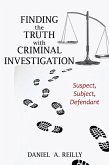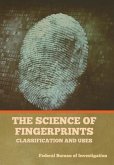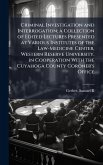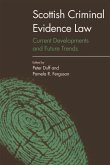Versandkostenfrei innerhalb Deutschlands
166,99 €
inkl. MwSt.
Versandkostenfrei*
Erscheint vorauss. 5. Februar 2026
Melden Sie sich
hier
hier
für den Produktalarm an, um über die Verfügbarkeit des Produkts informiert zu werden.
oder sofort lesen als eBook

83 °P sammeln
- Gebundenes Buch
What is the process for a successful criminal investigation? Finding the Truth with Criminal Investigation is intended to answer all of the questions of who, what, where, when, why and how a violent crime occurred and/or was committed. It is intended for students in the field of criminal justice who wish to become criminal investigators-exposing them to the tools and processes needed to conduct a proper criminal investigation, but also the reality of working to support others as a team. Author Daniel A. Reilly spent a great deal of his professional life working on homicide cases, and he offers…mehr
Andere Kunden interessierten sich auch für
![Finding the Truth with Criminal Investigation Finding the Truth with Criminal Investigation]() Daniel A ReillyFinding the Truth with Criminal Investigation121,99 €
Daniel A ReillyFinding the Truth with Criminal Investigation121,99 €![Quality Control in Fact-Finding Quality Control in Fact-Finding]() Quality Control in Fact-Finding37,99 €
Quality Control in Fact-Finding37,99 €![The Science of Fingerprints The Science of Fingerprints]() Federal Bureau Of InvestigationThe Science of Fingerprints27,99 €
Federal Bureau Of InvestigationThe Science of Fingerprints27,99 €![Crime Scene Chemistry for the Armchair Sleuth Crime Scene Chemistry for the Armchair Sleuth]() Cathy CobbCrime Scene Chemistry for the Armchair Sleuth21,99 €
Cathy CobbCrime Scene Chemistry for the Armchair Sleuth21,99 €![Criminal Investigation and Interrogation; a Collection of Edited Lectures Presented at Various Institutes of the Law-Medicine Center, Western Reserve University, in Cooperation With the Cuyahoga County Coroner's Office Criminal Investigation and Interrogation; a Collection of Edited Lectures Presented at Various Institutes of the Law-Medicine Center, Western Reserve University, in Cooperation With the Cuyahoga County Coroner's Office]() Criminal Investigation and Interrogation; a Collection of Edited Lectures Presented at Various Institutes of the Law-Medicine Center, Western Reserve University, in Cooperation With the Cuyahoga County Coroner's Office37,99 €
Criminal Investigation and Interrogation; a Collection of Edited Lectures Presented at Various Institutes of the Law-Medicine Center, Western Reserve University, in Cooperation With the Cuyahoga County Coroner's Office37,99 €![Scottish Criminal Evidence Law Scottish Criminal Evidence Law]() Scottish Criminal Evidence Law122,99 €
Scottish Criminal Evidence Law122,99 €![Suspect Documents Suspect Documents]() Wilson R HarrisonSuspect Documents122,99 €
Wilson R HarrisonSuspect Documents122,99 €-
-
-
What is the process for a successful criminal investigation? Finding the Truth with Criminal Investigation is intended to answer all of the questions of who, what, where, when, why and how a violent crime occurred and/or was committed. It is intended for students in the field of criminal justice who wish to become criminal investigators-exposing them to the tools and processes needed to conduct a proper criminal investigation, but also the reality of working to support others as a team. Author Daniel A. Reilly spent a great deal of his professional life working on homicide cases, and he offers students his expertise in criminal investigation by successfully incorporating real-world context throughout this book. Updates to this Second Edition include: - Updated illustrative cases reflecting current police investigations, to support theories and opinions about investigative steps and best practices - Additional content on crime scene investigation - Updated scholarship and supporting data - New images, charts, and graphs
Produktdetails
- Produktdetails
- Verlag: Bloomsbury Academic
- 2nd edition
- Seitenzahl: 464
- Erscheinungstermin: 5. Februar 2026
- Englisch
- Abmessung: 254mm x 178mm x 25mm
- Gewicht: 454g
- ISBN-13: 9798881801649
- Artikelnr.: 75577971
- Herstellerkennzeichnung
- Libri GmbH
- Europaallee 1
- 36244 Bad Hersfeld
- gpsr@libri.de
- Verlag: Bloomsbury Academic
- 2nd edition
- Seitenzahl: 464
- Erscheinungstermin: 5. Februar 2026
- Englisch
- Abmessung: 254mm x 178mm x 25mm
- Gewicht: 454g
- ISBN-13: 9798881801649
- Artikelnr.: 75577971
- Herstellerkennzeichnung
- Libri GmbH
- Europaallee 1
- 36244 Bad Hersfeld
- gpsr@libri.de
Daniel Reilly is adjunct faculty at George Mason University. Reilly worked for the Federal Bureau of Investigation for thirty years, including as a Special Agent Criminal Investigator. After his retirement from the FBI, Reilly worked as a private consulting analyst with the High Intensity Drug Trafficking Area (HIDTA) task force operations in the Mid-Atlantic region for ten years. He is the author of Finding the Truth with Criminal Investigations Suspect, Subject, Defendant (2019) and Working the Scene (2008) on crime scene examination. He has taught other law enforcement professionals in the U.S. and worldwide in a variety of fields related to criminal justice. Reilly has served as an expert witness in street gang and bank robbery cases.
Acknowledgements
Preface
PART I: THE FOUNDATION: JUST WHAT IS DUE PROCESS, WHAT ARE THE SUSPECT'S
CONSTITUTIONAL RIGHTS, AND HOW IS PROBABLE CAUSE DEFINED IN THE LAW
1. Criminal Investigations, Investigators, and Agencies
Defining What a Criminal Investigation Means: Reactive and Proactive
Scope of this Book
Types of Investigations
Investigators Defined
2. Criminal Code: Criminal Statutes and the Outline of What Needs to be
Proved
Positive Identification
Categories of Violent Crime
A Discussion Defining the Elements of a Crime
Chapter Summary
3. Constitutional Rights
The Rights of the Accused
Landmark Supreme Court Cases
Significant Supreme Court Cases Affecting the 4th Amendment Rights
Summary
4. Relationships Between Investigators, Prosecutors, And Forensic
Scientists (Teamwork)
Reactive Criminal Investigations
The Squad
Partners
Court Team
Special Units
Summary
5. Victims and Witnesses
Victim Witnesses
Victim Witnesses in Sexual Assault
Victim Witness Serious Violence
Other Victim Witnesses
Eyewitnesses and Fact Witnesses
Law Enforcement Professionals
Expert Witnesses
Summary
PART II: INVESTIGATIVE STEPS, PROCESSES AND PROCEDURES
6. Crime Scene Analysis
Classroom Exercise: A Preliminary Classroom Discussion Exercise in Crime
Scene Analysis
Commercial Crime Scenes: Commercial Burglaries, Commercial Armed Robberies
and Other Crimes in Business Establishments
Violent Crime Scenes: Homicides, Murders, Manslaughter, Rape, Mayhem and
Other Crimes of Violence with Serious Bodily Harm
Rape and Sexual Assault
Child Predators
Summary
7. Probable Cause and Proof Beyond a Reasonable Doubt
Probable Cause
Probable Cause Chart
Arrest Chart
Breona Taylor Case Study
Advancing an Investigation from Probable Cause to Proof Beyond a Reasonable
Doubt
Witness Concerns
Summary
8. Physical Evidence
Chain of Custody
Fingerprint Evidence
Serological Evidence (Blood, Sweat, Semen, Bodily Fluids)
Trace Evidence (Hairs and Fibers)
Ballistic Evidence (Guns, Rifles, Bullets, Ammunition, Tool Marks)
Toxicology (Drugs, Poisons, Suspicious Substances, that Need to be
Qualitatively and Quantitatively Analyzed.)
Medical Examiner (Pathologist and Coroner)
Documentary Material (Books, Records, Photographs, Digital Information and
Data; Pattern Evidence Like Shoe Prints and Tire Treads)
Computer Analysis
Summary
9. Interviews and Interrogations
Interview Techniques: Subject Interrogation and Recalcitrant Witnesses and
De-Briefings
Interview Research Studies
Academic Research on Interrogations and Troubling Interviews
Subject Interviews or Interrogations
Un-Repentant Subject Interviews
Controlling the Narrative
Subject Interviews Under Extreme Conditions
Interview and Interrogation Techniques
Location and Numbers
Summary
10. Confidential Informants
Administrative Concerns
Informant Reliability
Working Informants
How to Work a Source
11. Advanced Investigative Techniques
Covert Surveillance
Tactical Spin
Drug Investigations
Wholesale Drug Dealers
Undercover Operations
Title III Electronic Surveillance
Summary
12. Bringing a Case to Court
Initial Appearance
Preliminary Hearing
Grand Jury Hearing
Presentment or Arraignment
Timeline or Speedy Trial Requirements
Discovery
Miscellaneous Evidentiary Hearings
Guilty Pleas, Plea Deals, and Dismissal of Charges
Not Guilty
Insanity
Summary
PART III: ADMINISTRATIVE TASKS
13. Prioritizing Investigations
Prioritizing Based on Serious Violence
Property and Financial Crimes
Vice and Morals Investigations
Summary
14. Investigative Plan
The Plan
Step One, Compartment 1: Crimes Against Persons
Step One, Compartment 2: Property Crime Investigations
Step Two: Detail The Facts Known Cover Leads and Consider Theories about
the Crime
Step Two: Crime Against Persons
Step Two: Crimes Against Property
Intelligence
Probable Cause and Suspect
The Scientific Method
Summary
15. PREPARING A CASE FILE
Investigative File Categories
Case File Security
Lead Coverage
Search Warrants
Arrests
Summary
16. Investigative Intelligence
Crime Data
Big Data
Patrol Support
Community Support Activists
Prior Case File Reviews
Inter-Jurisdictional Cooperation
Summary
17. Tactical Considerations
Swat
Hand to Hand Combat
Deadly Force
Search Warrant Raids
Summary
18. Defense Investigations, Private Investigations, and Non-Sworn Officer
Investigations
Private Investigators
Defense Investigators
Summary
19. Epilogue
About the Author
Glossary
Notes
Bibliography
Bibliography for Other Significant Studies on Interview Techniques that are
Used to Detect Deception
Index
Preface
PART I: THE FOUNDATION: JUST WHAT IS DUE PROCESS, WHAT ARE THE SUSPECT'S
CONSTITUTIONAL RIGHTS, AND HOW IS PROBABLE CAUSE DEFINED IN THE LAW
1. Criminal Investigations, Investigators, and Agencies
Defining What a Criminal Investigation Means: Reactive and Proactive
Scope of this Book
Types of Investigations
Investigators Defined
2. Criminal Code: Criminal Statutes and the Outline of What Needs to be
Proved
Positive Identification
Categories of Violent Crime
A Discussion Defining the Elements of a Crime
Chapter Summary
3. Constitutional Rights
The Rights of the Accused
Landmark Supreme Court Cases
Significant Supreme Court Cases Affecting the 4th Amendment Rights
Summary
4. Relationships Between Investigators, Prosecutors, And Forensic
Scientists (Teamwork)
Reactive Criminal Investigations
The Squad
Partners
Court Team
Special Units
Summary
5. Victims and Witnesses
Victim Witnesses
Victim Witnesses in Sexual Assault
Victim Witness Serious Violence
Other Victim Witnesses
Eyewitnesses and Fact Witnesses
Law Enforcement Professionals
Expert Witnesses
Summary
PART II: INVESTIGATIVE STEPS, PROCESSES AND PROCEDURES
6. Crime Scene Analysis
Classroom Exercise: A Preliminary Classroom Discussion Exercise in Crime
Scene Analysis
Commercial Crime Scenes: Commercial Burglaries, Commercial Armed Robberies
and Other Crimes in Business Establishments
Violent Crime Scenes: Homicides, Murders, Manslaughter, Rape, Mayhem and
Other Crimes of Violence with Serious Bodily Harm
Rape and Sexual Assault
Child Predators
Summary
7. Probable Cause and Proof Beyond a Reasonable Doubt
Probable Cause
Probable Cause Chart
Arrest Chart
Breona Taylor Case Study
Advancing an Investigation from Probable Cause to Proof Beyond a Reasonable
Doubt
Witness Concerns
Summary
8. Physical Evidence
Chain of Custody
Fingerprint Evidence
Serological Evidence (Blood, Sweat, Semen, Bodily Fluids)
Trace Evidence (Hairs and Fibers)
Ballistic Evidence (Guns, Rifles, Bullets, Ammunition, Tool Marks)
Toxicology (Drugs, Poisons, Suspicious Substances, that Need to be
Qualitatively and Quantitatively Analyzed.)
Medical Examiner (Pathologist and Coroner)
Documentary Material (Books, Records, Photographs, Digital Information and
Data; Pattern Evidence Like Shoe Prints and Tire Treads)
Computer Analysis
Summary
9. Interviews and Interrogations
Interview Techniques: Subject Interrogation and Recalcitrant Witnesses and
De-Briefings
Interview Research Studies
Academic Research on Interrogations and Troubling Interviews
Subject Interviews or Interrogations
Un-Repentant Subject Interviews
Controlling the Narrative
Subject Interviews Under Extreme Conditions
Interview and Interrogation Techniques
Location and Numbers
Summary
10. Confidential Informants
Administrative Concerns
Informant Reliability
Working Informants
How to Work a Source
11. Advanced Investigative Techniques
Covert Surveillance
Tactical Spin
Drug Investigations
Wholesale Drug Dealers
Undercover Operations
Title III Electronic Surveillance
Summary
12. Bringing a Case to Court
Initial Appearance
Preliminary Hearing
Grand Jury Hearing
Presentment or Arraignment
Timeline or Speedy Trial Requirements
Discovery
Miscellaneous Evidentiary Hearings
Guilty Pleas, Plea Deals, and Dismissal of Charges
Not Guilty
Insanity
Summary
PART III: ADMINISTRATIVE TASKS
13. Prioritizing Investigations
Prioritizing Based on Serious Violence
Property and Financial Crimes
Vice and Morals Investigations
Summary
14. Investigative Plan
The Plan
Step One, Compartment 1: Crimes Against Persons
Step One, Compartment 2: Property Crime Investigations
Step Two: Detail The Facts Known Cover Leads and Consider Theories about
the Crime
Step Two: Crime Against Persons
Step Two: Crimes Against Property
Intelligence
Probable Cause and Suspect
The Scientific Method
Summary
15. PREPARING A CASE FILE
Investigative File Categories
Case File Security
Lead Coverage
Search Warrants
Arrests
Summary
16. Investigative Intelligence
Crime Data
Big Data
Patrol Support
Community Support Activists
Prior Case File Reviews
Inter-Jurisdictional Cooperation
Summary
17. Tactical Considerations
Swat
Hand to Hand Combat
Deadly Force
Search Warrant Raids
Summary
18. Defense Investigations, Private Investigations, and Non-Sworn Officer
Investigations
Private Investigators
Defense Investigators
Summary
19. Epilogue
About the Author
Glossary
Notes
Bibliography
Bibliography for Other Significant Studies on Interview Techniques that are
Used to Detect Deception
Index
Acknowledgements
Preface
PART I: THE FOUNDATION: JUST WHAT IS DUE PROCESS, WHAT ARE THE SUSPECT'S
CONSTITUTIONAL RIGHTS, AND HOW IS PROBABLE CAUSE DEFINED IN THE LAW
1. Criminal Investigations, Investigators, and Agencies
Defining What a Criminal Investigation Means: Reactive and Proactive
Scope of this Book
Types of Investigations
Investigators Defined
2. Criminal Code: Criminal Statutes and the Outline of What Needs to be
Proved
Positive Identification
Categories of Violent Crime
A Discussion Defining the Elements of a Crime
Chapter Summary
3. Constitutional Rights
The Rights of the Accused
Landmark Supreme Court Cases
Significant Supreme Court Cases Affecting the 4th Amendment Rights
Summary
4. Relationships Between Investigators, Prosecutors, And Forensic
Scientists (Teamwork)
Reactive Criminal Investigations
The Squad
Partners
Court Team
Special Units
Summary
5. Victims and Witnesses
Victim Witnesses
Victim Witnesses in Sexual Assault
Victim Witness Serious Violence
Other Victim Witnesses
Eyewitnesses and Fact Witnesses
Law Enforcement Professionals
Expert Witnesses
Summary
PART II: INVESTIGATIVE STEPS, PROCESSES AND PROCEDURES
6. Crime Scene Analysis
Classroom Exercise: A Preliminary Classroom Discussion Exercise in Crime
Scene Analysis
Commercial Crime Scenes: Commercial Burglaries, Commercial Armed Robberies
and Other Crimes in Business Establishments
Violent Crime Scenes: Homicides, Murders, Manslaughter, Rape, Mayhem and
Other Crimes of Violence with Serious Bodily Harm
Rape and Sexual Assault
Child Predators
Summary
7. Probable Cause and Proof Beyond a Reasonable Doubt
Probable Cause
Probable Cause Chart
Arrest Chart
Breona Taylor Case Study
Advancing an Investigation from Probable Cause to Proof Beyond a Reasonable
Doubt
Witness Concerns
Summary
8. Physical Evidence
Chain of Custody
Fingerprint Evidence
Serological Evidence (Blood, Sweat, Semen, Bodily Fluids)
Trace Evidence (Hairs and Fibers)
Ballistic Evidence (Guns, Rifles, Bullets, Ammunition, Tool Marks)
Toxicology (Drugs, Poisons, Suspicious Substances, that Need to be
Qualitatively and Quantitatively Analyzed.)
Medical Examiner (Pathologist and Coroner)
Documentary Material (Books, Records, Photographs, Digital Information and
Data; Pattern Evidence Like Shoe Prints and Tire Treads)
Computer Analysis
Summary
9. Interviews and Interrogations
Interview Techniques: Subject Interrogation and Recalcitrant Witnesses and
De-Briefings
Interview Research Studies
Academic Research on Interrogations and Troubling Interviews
Subject Interviews or Interrogations
Un-Repentant Subject Interviews
Controlling the Narrative
Subject Interviews Under Extreme Conditions
Interview and Interrogation Techniques
Location and Numbers
Summary
10. Confidential Informants
Administrative Concerns
Informant Reliability
Working Informants
How to Work a Source
11. Advanced Investigative Techniques
Covert Surveillance
Tactical Spin
Drug Investigations
Wholesale Drug Dealers
Undercover Operations
Title III Electronic Surveillance
Summary
12. Bringing a Case to Court
Initial Appearance
Preliminary Hearing
Grand Jury Hearing
Presentment or Arraignment
Timeline or Speedy Trial Requirements
Discovery
Miscellaneous Evidentiary Hearings
Guilty Pleas, Plea Deals, and Dismissal of Charges
Not Guilty
Insanity
Summary
PART III: ADMINISTRATIVE TASKS
13. Prioritizing Investigations
Prioritizing Based on Serious Violence
Property and Financial Crimes
Vice and Morals Investigations
Summary
14. Investigative Plan
The Plan
Step One, Compartment 1: Crimes Against Persons
Step One, Compartment 2: Property Crime Investigations
Step Two: Detail The Facts Known Cover Leads and Consider Theories about
the Crime
Step Two: Crime Against Persons
Step Two: Crimes Against Property
Intelligence
Probable Cause and Suspect
The Scientific Method
Summary
15. PREPARING A CASE FILE
Investigative File Categories
Case File Security
Lead Coverage
Search Warrants
Arrests
Summary
16. Investigative Intelligence
Crime Data
Big Data
Patrol Support
Community Support Activists
Prior Case File Reviews
Inter-Jurisdictional Cooperation
Summary
17. Tactical Considerations
Swat
Hand to Hand Combat
Deadly Force
Search Warrant Raids
Summary
18. Defense Investigations, Private Investigations, and Non-Sworn Officer
Investigations
Private Investigators
Defense Investigators
Summary
19. Epilogue
About the Author
Glossary
Notes
Bibliography
Bibliography for Other Significant Studies on Interview Techniques that are
Used to Detect Deception
Index
Preface
PART I: THE FOUNDATION: JUST WHAT IS DUE PROCESS, WHAT ARE THE SUSPECT'S
CONSTITUTIONAL RIGHTS, AND HOW IS PROBABLE CAUSE DEFINED IN THE LAW
1. Criminal Investigations, Investigators, and Agencies
Defining What a Criminal Investigation Means: Reactive and Proactive
Scope of this Book
Types of Investigations
Investigators Defined
2. Criminal Code: Criminal Statutes and the Outline of What Needs to be
Proved
Positive Identification
Categories of Violent Crime
A Discussion Defining the Elements of a Crime
Chapter Summary
3. Constitutional Rights
The Rights of the Accused
Landmark Supreme Court Cases
Significant Supreme Court Cases Affecting the 4th Amendment Rights
Summary
4. Relationships Between Investigators, Prosecutors, And Forensic
Scientists (Teamwork)
Reactive Criminal Investigations
The Squad
Partners
Court Team
Special Units
Summary
5. Victims and Witnesses
Victim Witnesses
Victim Witnesses in Sexual Assault
Victim Witness Serious Violence
Other Victim Witnesses
Eyewitnesses and Fact Witnesses
Law Enforcement Professionals
Expert Witnesses
Summary
PART II: INVESTIGATIVE STEPS, PROCESSES AND PROCEDURES
6. Crime Scene Analysis
Classroom Exercise: A Preliminary Classroom Discussion Exercise in Crime
Scene Analysis
Commercial Crime Scenes: Commercial Burglaries, Commercial Armed Robberies
and Other Crimes in Business Establishments
Violent Crime Scenes: Homicides, Murders, Manslaughter, Rape, Mayhem and
Other Crimes of Violence with Serious Bodily Harm
Rape and Sexual Assault
Child Predators
Summary
7. Probable Cause and Proof Beyond a Reasonable Doubt
Probable Cause
Probable Cause Chart
Arrest Chart
Breona Taylor Case Study
Advancing an Investigation from Probable Cause to Proof Beyond a Reasonable
Doubt
Witness Concerns
Summary
8. Physical Evidence
Chain of Custody
Fingerprint Evidence
Serological Evidence (Blood, Sweat, Semen, Bodily Fluids)
Trace Evidence (Hairs and Fibers)
Ballistic Evidence (Guns, Rifles, Bullets, Ammunition, Tool Marks)
Toxicology (Drugs, Poisons, Suspicious Substances, that Need to be
Qualitatively and Quantitatively Analyzed.)
Medical Examiner (Pathologist and Coroner)
Documentary Material (Books, Records, Photographs, Digital Information and
Data; Pattern Evidence Like Shoe Prints and Tire Treads)
Computer Analysis
Summary
9. Interviews and Interrogations
Interview Techniques: Subject Interrogation and Recalcitrant Witnesses and
De-Briefings
Interview Research Studies
Academic Research on Interrogations and Troubling Interviews
Subject Interviews or Interrogations
Un-Repentant Subject Interviews
Controlling the Narrative
Subject Interviews Under Extreme Conditions
Interview and Interrogation Techniques
Location and Numbers
Summary
10. Confidential Informants
Administrative Concerns
Informant Reliability
Working Informants
How to Work a Source
11. Advanced Investigative Techniques
Covert Surveillance
Tactical Spin
Drug Investigations
Wholesale Drug Dealers
Undercover Operations
Title III Electronic Surveillance
Summary
12. Bringing a Case to Court
Initial Appearance
Preliminary Hearing
Grand Jury Hearing
Presentment or Arraignment
Timeline or Speedy Trial Requirements
Discovery
Miscellaneous Evidentiary Hearings
Guilty Pleas, Plea Deals, and Dismissal of Charges
Not Guilty
Insanity
Summary
PART III: ADMINISTRATIVE TASKS
13. Prioritizing Investigations
Prioritizing Based on Serious Violence
Property and Financial Crimes
Vice and Morals Investigations
Summary
14. Investigative Plan
The Plan
Step One, Compartment 1: Crimes Against Persons
Step One, Compartment 2: Property Crime Investigations
Step Two: Detail The Facts Known Cover Leads and Consider Theories about
the Crime
Step Two: Crime Against Persons
Step Two: Crimes Against Property
Intelligence
Probable Cause and Suspect
The Scientific Method
Summary
15. PREPARING A CASE FILE
Investigative File Categories
Case File Security
Lead Coverage
Search Warrants
Arrests
Summary
16. Investigative Intelligence
Crime Data
Big Data
Patrol Support
Community Support Activists
Prior Case File Reviews
Inter-Jurisdictional Cooperation
Summary
17. Tactical Considerations
Swat
Hand to Hand Combat
Deadly Force
Search Warrant Raids
Summary
18. Defense Investigations, Private Investigations, and Non-Sworn Officer
Investigations
Private Investigators
Defense Investigators
Summary
19. Epilogue
About the Author
Glossary
Notes
Bibliography
Bibliography for Other Significant Studies on Interview Techniques that are
Used to Detect Deception
Index







